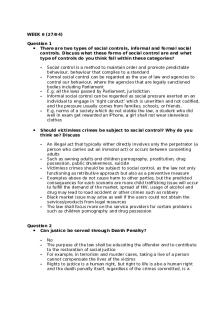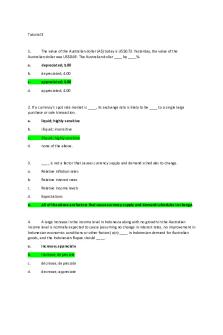DEL tutorial 3 PDF

| Title | DEL tutorial 3 |
|---|---|
| Course | Law of Delict |
| Institution | University of the Western Cape |
| Pages | 2 |
| File Size | 46.3 KB |
| File Type | |
| Total Downloads | 2 |
| Total Views | 259 |
Summary
As a measure for controlling potholes, Siyanqoba Municipality laid cobble stones on a public road. They however failed to maintain the road thereafter, and the cobble stones became smooth, rendering the road dangerous. Mr. King was travelling along this public road in his horse-drawn carriage, when ...
Description
As a measure for controlling potholes, Siyanqoba Municipality laid cobble stones on a public road. They however failed to maintain the road thereafter, and the cobble stones became smooth, rendering the road dangerous. Mr. King was travelling along this public road in his horse-drawn carriage, when his horse slipped, and he was thrown out of the carriage. As a result, he suffered bodily injuries. Advise your client; Mr. King on the prospects of his claim against the municipality. In your answer address the following issues: a) b) c) d)
The parties to the claim The harm suffered by Mr. King and delictual action applicable The type of conduct displayed by Siyanqoba Municipality Whether or not Siyanqoba Municipality is the cause of Mr. King’s harm
Answer In the scenario mentioned the plaintiff is Mr King, who suffered the harm, and Siyanqoba Municipality is the defendant. To determine whether the plaintiff’s claim will succeed one first needs to determine what form of harm was suffered. Foreseeability Patrimonial harm can be defined as the detrimental impact on any patrimonial interest that is protected by law. With this type of harm the plaintiff can actually prove in court that they have suffered a loss, it is quantifiable. For example, the presentation of medical expenses. In this scenario Mr King suffered patrimonial harm associated with personal injury, damage to property and pure economic loss. This is because Mr King suffered bodily injuries and his property got damages (horse and carriage); this gives rise to future expenses and loss of future income. The delictual action available for patrimonial harm is the actio legis Aquiliae. This action is used to place the plaintiff in the same position was they were as if the delict did not occur. However, the harm suffered by Mr King could also be non-patrimonial harm. This is all forms of harm that cannot be calculated in terms of monetary value. Mr King would have suffered non-patrimonial harm in the form of pain and suffering. This is related with physical injury to the plaintiff. The delictual action available for this form of non-patrimonial harm is the Germanic action for pain and suffering. We have to categorize the type of conduct displayed by Siyanqoba Municipality. The defendant must have caused the harm to the plaintiff by the means of a commission or an omission. The conduct must also be a voluntary human act (commission) or omission. In the case of Siyanqoba Municipality, the type of conduct displayed by them was in the form of an omission. An omission is a form of negative conduct as it arises out of the failure to act. This is because they failed to maintain the road after they laid the cobble stones. We now have to identify whether or not Siyanqoba Municipality is the cause of Mr King’s harm. For a delict to have occurred there has to be a causal nexus between the defendant’s conduct or omission and the harm suffered by the plaintiff. The causal nexus is made up of two types of causation, namely factual causation (causal nexus in fact) and legal causation (causal nexus in law). Both types of causation need to be satisfied for the defendant to be the cause of the harm.
First, one has to establish factual causation. We use the “But-for” test, this basically says “but-for” the defendant’s conduct would the harm have occurred? If the answer is yes, factual causation is not present. If the answer is no, this means that the defendant’s conduct was the factual cause of the harm. In the case of Siyanqoba Municipality, “but-for” their omission, would Mr King have suffered the harm. The answer is no, therefore, Siyanqoba Municipality is the factual cause of Mr King’s harm. We also have the condition sine qua non test; this involves hypothetical substitution (for omissions) or hypothetical elimination (for commissions). In terms of Siyanqoba Municipality, if they had acted the harm Mr King suffered would not have occurred; therefore the omission is a conditio sine qua non. After factual causation has been satisfied we have to move to legal causation. To determine legal causation we make use of the factual approach, using the reasonable foreseeability test. This test states that a defendant is only liable for the consequences which a reasonable person in their position would have reasonably foreseen. Therefore, Siyanqoba Municipality can only be liable for the harm Mr King suffered if a reasonable person in their position would have reasonably foreseen the harm. In this case, a reasonable person would have foreseen Mr King’s harm....
Similar Free PDFs

DEL tutorial 3
- 2 Pages

Tutorial 3
- 3 Pages

Tutorial 3
- 4 Pages

Tutorial 3
- 4 Pages

Tutorial 3
- 12 Pages

3 - tutorial
- 6 Pages

Tutorial 3
- 6 Pages

Tutorial 3
- 4 Pages

Tutorial 3 - Lecture notes 3
- 5 Pages

Tutorial 3 Answers
- 4 Pages

Tutorial 3 Solutions - EC202
- 4 Pages

Tutorial 3 Solution - investment
- 3 Pages

Tutorial 3 - ccc
- 1 Pages

Tutorial work - 1 - 3
- 31 Pages

Tutorial 3 - Answers
- 6 Pages

OD tutorial 3
- 5 Pages
Popular Institutions
- Tinajero National High School - Annex
- Politeknik Caltex Riau
- Yokohama City University
- SGT University
- University of Al-Qadisiyah
- Divine Word College of Vigan
- Techniek College Rotterdam
- Universidade de Santiago
- Universiti Teknologi MARA Cawangan Johor Kampus Pasir Gudang
- Poltekkes Kemenkes Yogyakarta
- Baguio City National High School
- Colegio san marcos
- preparatoria uno
- Centro de Bachillerato Tecnológico Industrial y de Servicios No. 107
- Dalian Maritime University
- Quang Trung Secondary School
- Colegio Tecnológico en Informática
- Corporación Regional de Educación Superior
- Grupo CEDVA
- Dar Al Uloom University
- Centro de Estudios Preuniversitarios de la Universidad Nacional de Ingeniería
- 上智大学
- Aakash International School, Nuna Majara
- San Felipe Neri Catholic School
- Kang Chiao International School - New Taipei City
- Misamis Occidental National High School
- Institución Educativa Escuela Normal Juan Ladrilleros
- Kolehiyo ng Pantukan
- Batanes State College
- Instituto Continental
- Sekolah Menengah Kejuruan Kesehatan Kaltara (Tarakan)
- Colegio de La Inmaculada Concepcion - Cebu